Cloud Data Governance Explained: The Ultimate Guide for Business
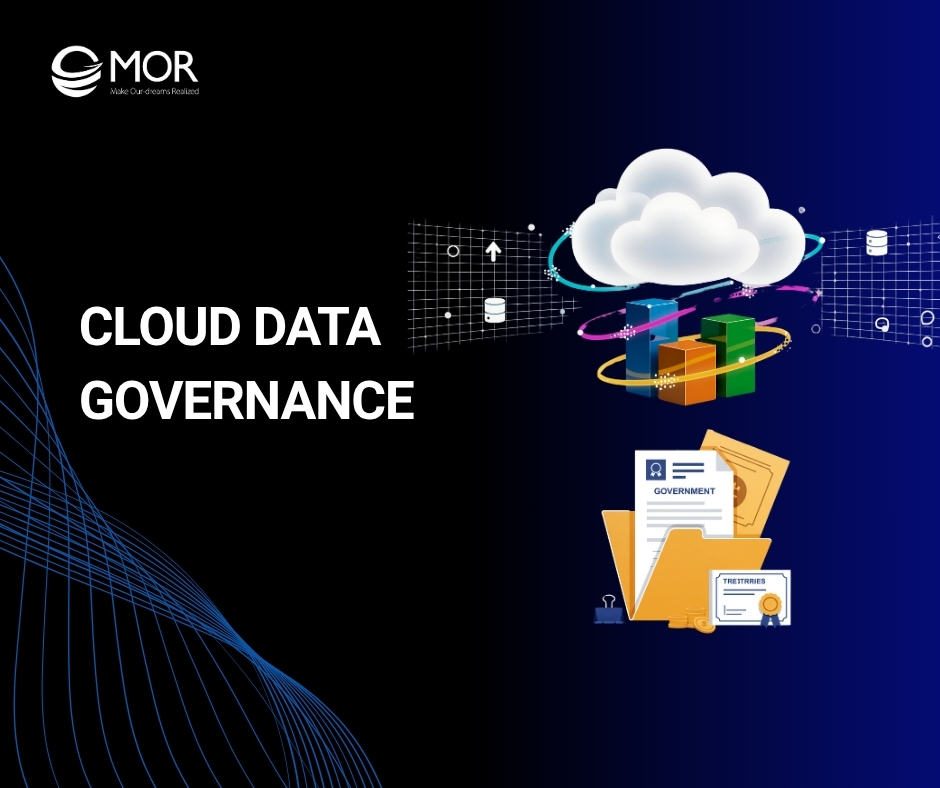
Uncontrolled data growth across multiple platforms can expose serious security and compliance risks. A clear cloud data governance strategy helps businesses manage, protect, and use data effectively. In this guide, MOR Software explains how strong data governance in the cloud ensures transparency, reduces risks, and supports smarter decision-making for long-term business growth.
What Is Cloud Data Governance?
Cloud data governance is a structured approach that defines how organizations manage, protect, and control their data within cloud environments. It establishes clear policies, processes, and technologies to ensure every dataset remains secure, accurate, and compliant.
In practice, data governance in the cloud helps maintain consistency across platforms, safeguard sensitive records, and align with regional or industry-specific regulations. These rules create a unified system for handling data storage, access, and contract lifecycle management software across multiple cloud providers.
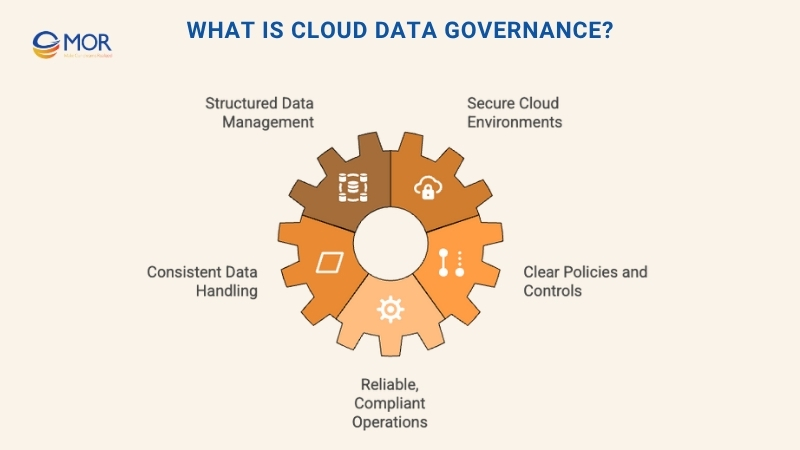
A well-designed governance program allows businesses to balance flexibility with control. It outlines how data is classified, who can access it, and how long it should be retained. This level of oversight minimizes risks and improves reliability, giving organizations confidence that their cloud data remains trustworthy and auditable.
Through proper governance, teams can make better use of their data assets while staying compliant with evolving standards. In short, effective cloud data governance helps enterprises capture the advantages of cloud computing without compromising security, privacy, or performance.
How Does Cloud Data Governance Work?
Cloud data governance functions as a continuous system that keeps business data secure, consistent, and ready for use across all environments. It combines policies, tools, and human oversight to manage how data is stored, accessed, and protected. Below are the essential steps that define how data governance cloud operates within an organization.
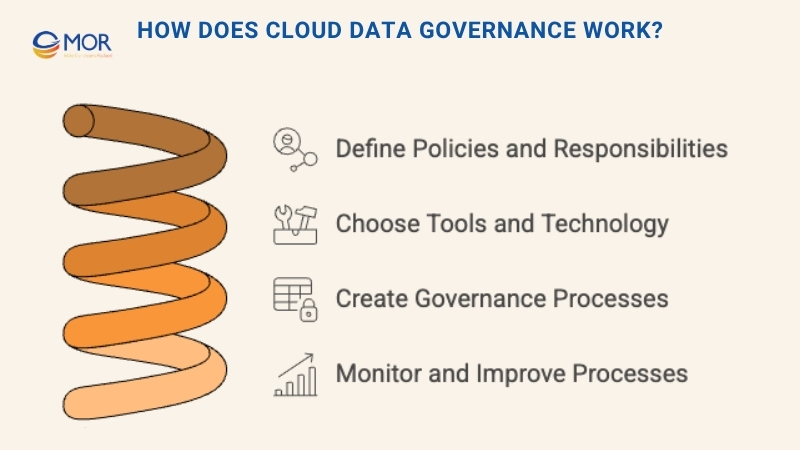
Step 1 – Define Policies and Responsibilities
Establishing clear rules is the foundation of effective cloud based data governance. This step involves creating policies for data quality, privacy, retention, and compliance with relevant laws. Every policy serves as a blueprint that guides how teams handle and protect information. Assigning dedicated data owners or stewards ensures accountability, as they maintain standards, enforce policies, and respond to data-related issues.
Step 2 – Choose the Right Tools and Technology
Technology plays a major role in executing the cloud data governance framework. Businesses rely on modern cloud data governance tools that automate profiling, cleansing, and enrichment to maintain accuracy. Encryption, authentication, and access controls strengthen security while allowing authorized users to interact safely with critical datasets. These combined measures help sustain both trust and compliance across cloud systems.
Step 3 – Create Governance Processes
Building structured processes ensures that governance policies translate into daily operations. Effective data governance in cloud requires clear workflows for data ingestion, validation, archival, and removal. It also includes defining role-based permissions, setting up monitoring consensus mechanisms, and implementing quick incident response steps to address potential data risks or breaches promptly.
Step 4 – Monitor and Continuously Improve
Governance is never static. Teams must track metrics such as quality scores, compliance status, and access activity to evaluate performance. Regular reviews help identify weaknesses and guide necessary updates to policies or tools. Through this ongoing improvement cycle, data governance in cloud computing stays aligned with new regulations, technologies, and business priorities, keeping data reliable and secure over time.
Cloud Data Governance Models Based On Architecture
Different architectures call for tailored approaches to cloud data governance, since each environment manages control, scalability, and compliance differently. When implementing data governance on cloud, understanding how these models vary helps organizations design strategies that fit both operational and regulatory needs.
Cloud Model | Key Characteristics | Specialized Tools |
Public cloud | Quick deployment, flexible scalability, less infrastructure ownership | Policy automation engines, cloud-native metadata catalogs |
Private cloud | Dedicated environment, stronger access control, higher customization | On-premises governance suites, advanced identity management tools |
Hybrid cloud | Merges public and private, demands synchronized governance layers | Cross-cloud management systems, unified policy orchestration tools |
Each setup delivers unique benefits and challenges. Public cloud environments offer speed and reach but limit direct control over infrastructure. Private clouds provide greater oversight and security, though they can slow down scaling. Hybrid cloud models require cohesive governance frameworks that keep policies consistent across multiple platforms. Choosing the right model ensures smoother control, data reliability, and regulatory alignment across every environment.
Why Cloud Data Governance Is Important For Businesses
In today’s data-driven operations, cloud data governance plays a key role in keeping information secure, compliant, and reliable across all systems. It helps organizations manage their data more responsibly while building trust with customers, partners, and regulators.
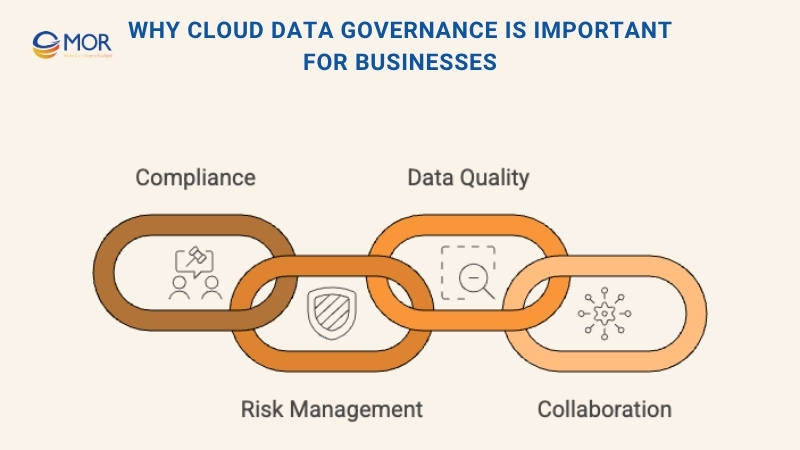
- Compliance: Many industries face strict privacy and data protection laws. A strong governance structure ensures that organizations meet these regulatory requirements by setting rules for how data is accessed, used, and shared across cloud platforms.
- Risk Management: Proper governance reduces the chance of breaches, data leaks, or unauthorized access. By applying consistent controls and permissions, businesses strengthen protection for sensitive information and minimize potential exposure.
- Data Quality: Maintaining accuracy and consistency across datasets is a critical part of data governance in the cloud. Setting clear validation rules and quality checks ensures reliable insights, supports analytics, and minimizes costly errors.
- Collaboration: With shared standards for managing data, teams across departments can work more effectively. Governance provides a unified approach that promotes transparency and encourages responsible data use throughout the organization.
Ultimately, effective cloud data governance gives businesses confidence that their information is trustworthy, their operations are compliant, and their decisions are based on accurate, well-managed data.
>>> The cloud cost is often less predictable than it seems, with expenses adding up quickly. Understand the real numbers and manage them with confidence right here!
Core Principles Of Cloud Data Governance
Strong cloud data governance relies on well-defined principles that guide how organizations handle, protect, and use their data across environments. These seven core values form the foundation for sustainable governance programs.
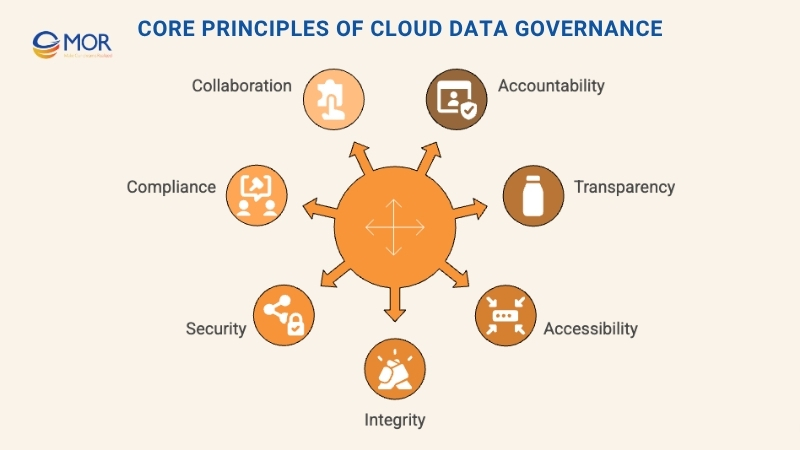
- Accountability: Everyone involved in data handling must take responsibility for maintaining accuracy, privacy, and compliance. Clear ownership ensures that each dataset is properly managed and regularly reviewed.
- Transparency: Governance policies should be open and easy to understand. When teams know how data is collected, stored, and used, it fosters trust and promotes consistent decision-making.
- Accessibility: Authorized users should be able to reach the information they need quickly, while strict controls prevent access to sensitive or confidential data.
- Integrity: Data must remain accurate, consistent, and complete throughout its lifecycle. Validation checks and version control help preserve reliability in every process.
- Security: Protecting information from unauthorized access or loss is central to cloud data governance. Encryption, monitoring, and recovery systems safeguard critical assets and minimize disruption.
- Compliance: Adhering to privacy laws, security regulations, and industry standards ensures responsible data handling and prevents legal or financial consequences.
- Collaboration: Teams across departments should align on shared practices and goals. Open communication helps maintain consistency and supports organization-wide governance success.
While different sectors may adapt additional rules, these seven principles provide a strong starting point for building a reliable and effective cloud data governance strategy.
Real-World Examples Of Cloud Data Governance
Effective cloud data governance is already transforming how global organizations manage and secure their information. Below are a few real-world cases that show how industry leaders apply governance frameworks to balance compliance, privacy, and performance.
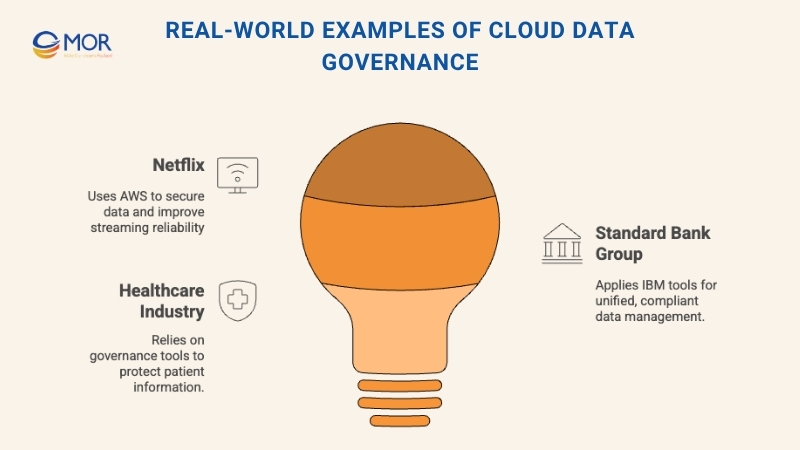
Netflix
Netflix handles massive volumes of viewer data to personalize content and improve recommendations while maintaining strong privacy standards under global regulations such as GDPR. Partnering with Amazon Web Services (AWS), Netflix uses EC2 for scalable compute power and S3 for secure data storage and access. It also leverages AWS Global Accelerator to enhance performance and protect against DDoS threats, improving streaming reliability and user safety across regions.
Standard Bank Group
Standard Bank Group, one of Africa’s largest financial institutions, applies IBM’s enterprise-grade governance systems to manage sensitive financial data securely. Using IBM Cloud Pak for Data and Watson Knowledge Catalog, the bank built a modern governance structure that unifies its data assets, improves transparency, and ensures compliance across multiple jurisdictions.
Healthcare Industry
Healthcare organizations manage large quantities of confidential patient and research data that demand strict control. Their cloud data governance models focus on access restrictions, data lineage, anonymization, and version tracking to protect privacy and maintain accuracy. Common enterprise tools, including Collibra, Ataccama, Informatica, and Atlan, support these practices by combining automation with regulatory compliance, allowing the healthcare sector to maintain trust and data integrity across digital systems.
Compliance In Cloud Data Governance
In October 2024, LinkedIn faced a €310 million fine from Ireland’s Data Protection Commission for processing personal data without proper consent under GDPR. The case highlighted that even major global companies are subject to the same strict privacy and data protection rules as everyone else.
That’s why compliance with frameworks like GDPR, HIPAA, and CCPA is no longer optional. Strong cloud data governance is the foundation that helps organizations stay compliant and avoid costly penalties. It ensures that data is stored, transferred, and processed only within authorized regions while tracking every movement to prevent violations.
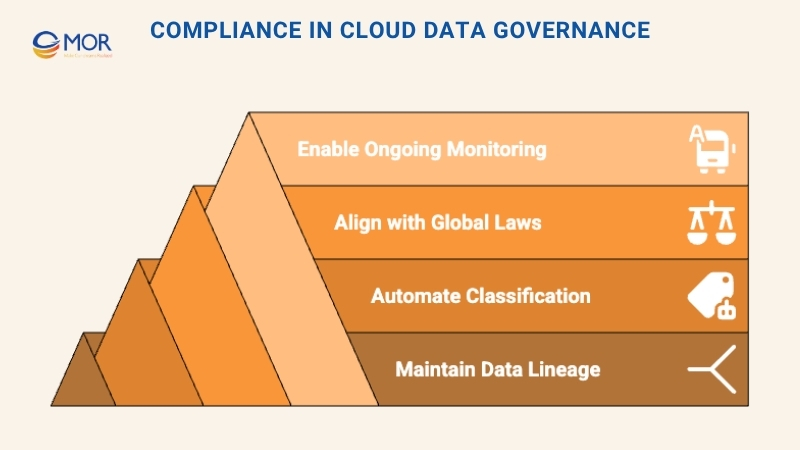
Through detailed monitoring, businesses can maintain audit-ready records of who accessed specific datasets and when. Integrating compliance into daily operations turns governance into a proactive shield rather than a reactive task.
- Maintain data lineage: Continuously document data flow and usage to provide transparent audit trails.
- Automate classification: Deploy intelligent tools to identify and label sensitive data, ensuring that proper security and privacy controls are applied.
- Align with global laws: Build governance frameworks that directly map to legal requirements, minimizing compliance risks.
- Enable ongoing monitoring: Conduct regular reviews of data access, permissions, and enforcement policies to detect gaps and strengthen overall compliance posture.
Adopting a structured approach to cloud data governance Informatica and similar compliance-ready platforms helps organizations manage evolving legal standards with confidence.
Common Cloud Data Governance Challenges
Even with its many advantages, cloud data governance comes with several ongoing challenges that can undermine security and consistency if not addressed properly.
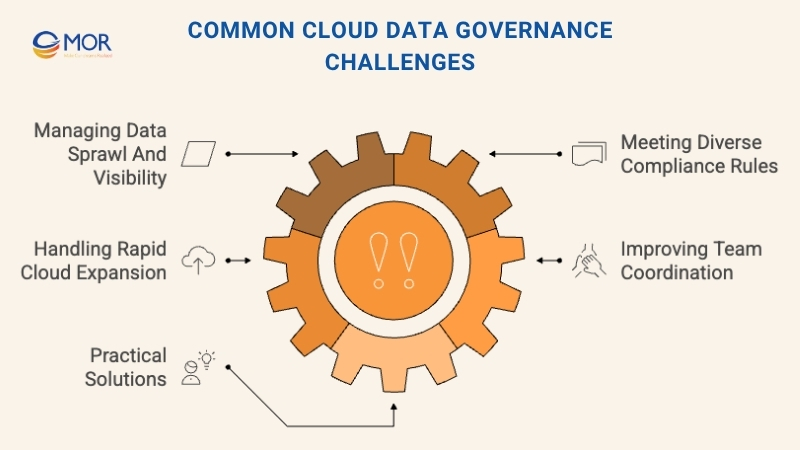
Managing Data Sprawl and Visibility
As companies expand into multi-cloud and hybrid environments, data often spreads across numerous platforms and services. Without a unified structure, tracking its movement becomes difficult, leading to duplication, inconsistency, and weakened control. When visibility drops, so does accountability.
A lack of centralized monitoring opens doors for unauthorized access during various stages of the data lifecycle. The 2024 breach affecting Snowflake accounts at major firms like Ticketmaster and AT&T made headlines for exactly that reason. Attackers exploited weak passwords and the absence of multi-factor authentication, gaining access with alarming ease.
This incident serves as a warning: without strong oversight and clear security enforcement, even the most advanced cloud setups remain vulnerable. Implementing structured policies and reliable monitoring systems through cloud data governance is no longer optional, it’s a necessity for protecting critical business assets.
Meeting Diverse Compliance Rules
Each regulatory framework imposes its own set of rules, making compliance a complex and ongoing task. The challenge grows when businesses manage data across regions with differing privacy laws, requiring them to track and adapt to changing standards continuously.
Neglecting these obligations can trigger investigations and steep penalties. A recent example is Microsoft, which holds around 20% of the global cloud market and was placed under review by the U.S. Federal Trade Commission for alleged anti-competitive practices in its cloud operations.
This underscores why cloud data governance must include built-in mechanisms for monitoring compliance across jurisdictions. By aligning governance structures with evolving legal demands, organizations can minimize regulatory risks and maintain trust with regulators and customers alike.
Handling Rapid Cloud Expansion
Cloud adoption continues to accelerate, with worldwide spending projected to reach $675 billion in 2024, a 20% rise from the previous year. This rapid growth means data environments are constantly evolving, adding new workloads, integrations, and tools at an unprecedented pace. Managing them efficiently has become a significant challenge.
Older governance systems often struggle in this setting. They were built for static environments, not for today’s dynamic and scalable infrastructure. As a result, maintaining security, consistency, and compliance becomes increasingly difficult.
To address this, organizations need modern cloud data governance models that adapt in real time. These frameworks automate repetitive controls, scale alongside infrastructure, and maintain visibility across every platform, helping teams stay focused on innovation instead of firefighting compliance or configuration issues.
Improving Team Coordination
Effective cloud data governance depends on collaboration across IT, security, data, and business teams. Yet, aligning these groups can be difficult since each operates with different priorities, systems, and workflows. When coordination breaks down, decision-making slows and critical governance responsibilities may fall through the cracks.
Practical Solutions
Centralized cloud data governance and catalog systems, supported by agile governance methods, can bridge these gaps. Automation helps reduce manual tracking and policy enforcement, freeing teams to focus on higher-value tasks.
At the same time, well-structured data catalogs organize and connect metadata, improving transparency and helping stakeholders locate, classify, and manage data efficiently. Because these solutions are adaptable, organizations can refine policies and workflows as their cloud environments expand, without rebuilding governance processes from the ground up.
>>> Highlight the top salesforce commerce cloud consultant you can work with in 2025 to ensure growth and long-term success
Best Practices For Effective Cloud Data Governance
Successful cloud data governance doesn’t rely on one tool or policy. It’s a continuous process that embeds strong habits into how teams manage, protect, and use data while staying adaptable to change. Below are six proven ways to make governance work in practice.
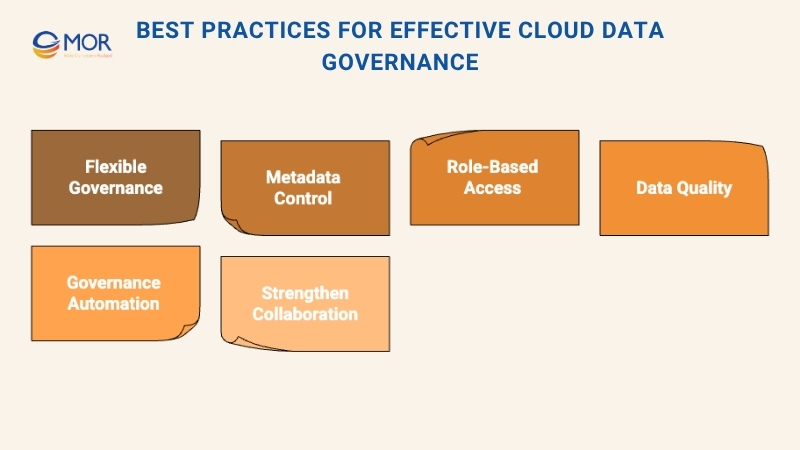
Build Flexible, Agile Governance
Governance should evolve, not restrict. Instead of enforcing rigid policies, focus on steady, measurable improvements. Start small, validate what works, and scale up. This agile mindset keeps governance aligned with business needs and ensures it grows alongside your expanding cloud ecosystem.
Leverage Metadata for Control
Metadata provides vital context, where data originated, who owns it, and how it’s used. Incorporating a cloud data governance and catalog strategy helps map and manage this information effectively. It enhances visibility, making it easier to classify, secure, and apply consistent policies to the right datasets.
Enforce Role-Based Access
Access control remains one of the simplest yet strongest defenses. Implement Role-Based Access Control (RBAC) so individuals can only view or modify data relevant to their responsibilities. Limiting exposure helps reduce internal risks and maintain regulatory compliance.
Prioritize Data Quality and Traceability
Reliable decisions depend on high-quality data. Maintain integrity by cleaning datasets regularly and documenting data lineage to show how it changes over time. Consistency builds trust and enables accurate reporting across departments.
Automate Governance Processes
Automation streamlines repetitive activities such as tagging, validation, and compliance checks. By embedding automation into your cloud data governance model, you reduce manual errors, enforce policies uniformly, and free your teams to focus on innovation instead of maintenance.
Strengthen Collaboration
Effective governance involves shared ownership. Encourage IT, security, and business units to collaborate through unified platforms and open communication. Shared visibility keeps governance strategies connected to organizational goals and ensures everyone plays an active role in protecting valuable data assets.
MOR Software: Your Trusted Partner For Compliant Cloud Data Governance
At MOR Software, we help businesses take control of their cloud data with secure, compliant, and well-structured governance frameworks. Our team combines years of cloud consulting experience with strong technical capabilities to ensure your data remains accurate, protected, and audit-ready across every platform.
We bring a proven track record in developing and managing enterprise-level systems across industries like hospice CRM software, finance, and manufacturing, all of which demand the highest data protection standards. With certified experts and ISO 27001:2013 compliance, we design governance CRM solutions that align with global regulations such as GDPR, HIPAA, and CCPA. This ensures your organization not only meets compliance requirements but also builds long-term trust with customers and partners.
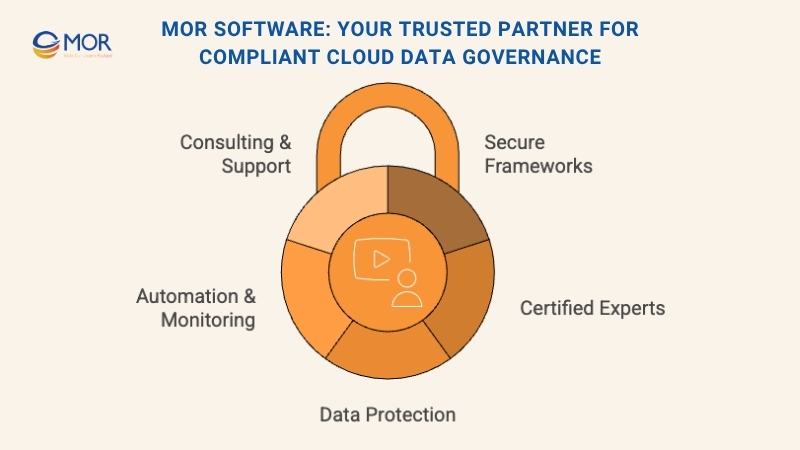
Our approach integrates automation, version-controlled CI/CD pipelines, and continuous monitoring to prevent configuration drift and unauthorized access. Each solution is tailored to your cloud architecture, whether public, private, or hybrid. We also implement policy enforcement, role-based access control, and data lineage tracking to maintain transparency and accountability across teams.
Beyond deployment, we provide ongoing consulting and maintenance, helping your business stay ahead of evolving data privacy laws and security challenges. From data classification to cross-platform integration, MOR Software empowers your organization with clear visibility, consistent standards, and confidence in every audit.
Contact us to build a compliant, future-ready cloud data governance framework with MOR Software.
Conclusion
Effective cloud data governance is no longer optional, it’s a necessity for security, compliance, and business growth. With clear policies, automation, and collaboration, organizations can turn data into a trusted asset instead of a hidden risk. MOR Software helps you build governance frameworks that align with global standards and evolve with your infrastructure. Ready to strengthen your cloud data strategy? Contact MOR Software today to create a secure and compliant foundation for your business.
MOR SOFTWARE
Frequently Asked Questions (FAQs)
What is cloud data governance?
Cloud data governance refers to the policies, processes, and technologies that control how data is stored, accessed, and protected in cloud environments. It ensures security, quality, and compliance across all data assets.
Why is cloud data governance important for businesses?
It helps organizations maintain data accuracy, protect sensitive information, and comply with regulations like GDPR or HIPAA. Effective governance also builds customer trust and improves decision-making.
What are the key components of a strong cloud data governance framework?
A complete framework includes data classification, access control, data lifecycle management, quality assurance, compliance monitoring, and continuous auditing.
How does cloud data governance differ from traditional data governance?
Traditional governance focuses on on-premise systems, while cloud data governance addresses distributed, multi-cloud, and hybrid environments that require greater flexibility, automation, and security controls.
Who is responsible for managing cloud data governance?
Typically, a data governance team includes data stewards, security officers, compliance managers, and IT administrators working together to enforce policies and monitor performance.
How can automation support cloud data governance?
Automation helps detect policy violations, classify data, monitor access, and generate audit logs. It reduces manual effort and keeps governance consistent across complex cloud environments.
What are the biggest challenges in cloud data governance?
Common challenges include data sprawl, inconsistent access policies, evolving compliance regulations, and managing visibility across multiple platforms.
How do organizations ensure compliance in cloud data governance?
They use tools for automated classification, track data lineage, conduct regular audits, and align policies with regional data protection laws and industry standards.
What best practices improve cloud data governance?
Adopting agile governance models, enforcing role-based access, using metadata-driven strategies, and fostering collaboration across IT and business teams are all key to success.
Rate this article
0
over 5.0 based on 0 reviews
Your rating on this news:
Name
*Email
*Write your comment
*Send your comment
1